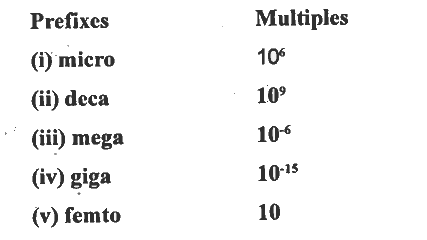Complete Solutions to ONE MARK QUESTIONS AND ANSWERS of chapter SOME BASIC CONCEPTS OF CHEMISTRY of Class 11 book with complete answers and questions
| Class 11 | CHEMISTRY |
| Chapter | SOME BASIC CONCEPTS OF CHEMISTRY |
| SUBHASH PUBLICATION | ONE MARK QUESTIONS AND ANSWERS |
| Number Of Questions | 60 |
| Academic Year | 2023-24 |
Define compounds.
03:49View SolutionDefine Atomic weight.
03:26View SolutionGive an example for compounds.
04:11View SolutionDefine mixtures.
03:24View SolutionGive an example for mixtures.
03:09View SolutionDefine mixtures.
03:24View SolutionDefine atom.
02:43View SolutionDefine molecule.
04:58View SolutionWhat is a unit?
03:36View SolutionDefine avogadro's law.
04:21View SolutionGive the S.I. unit of Length.
02:36View SolutionGive the S.I. unit of Mass.
03:35View SolutionWhat is the physical quantity of mole?
02:36View SolutionWhat is the physical quantity of ampere.
02:23View SolutionGive the SI unit of density
02:28View SolutionGive the SI unit of a Force b.Energy c.Pressure
07:29View SolutionWrite the scientific notation of 1,86,000
04:17View SolutionWrite the S.I. base unit for 1 day.
03:35View SolutionWrite 93 million mile in SI unit
03:43View SolutionDefine empirical formula.
04:33View SolutionDefine Molecular formula.
04:47View SolutionWhat is the relation between empirical and molecular formula?
05:58View SolutionExpress `46^(@)` C in SI unit.
02:02View SolutionDefine law of conservation of mass.
04:37View SolutionWrite 50000 g in exponential form (3 significant figures).
03:51View SolutionWrite 53400 g in exponented form (significant figures).
02:59View SolutionWhat physical quantities are represented by the following units and what are their most common names? (i) kg m `s^(-2)`, (ii) `kg m^(2)s^(-2)`, (iii) `dm^(3)`
06:24View SolutionWho discovered law of conservation of mass.
01:52View SolutionClassify the following substances into elements, compounds and mixtures: (i) Milk, (ii) 22-caret gold , (iii) Iodized table salt , (iv) Diamond, (v) Smoke, (vi) Steel, (vii) Brass, (viii) Dry ice (ix) Mercury, (x) Air, (xi) Aerated drinks, (xii) Glucose, (xiii) Petrol/Diesel/Kerosene oil, (xiv) Steam (xv) cloud.
08:53View SolutionWhy is air sometimes considered as a heterogenous mixture?
05:47View SolutionWho discovered law of constant composition a definite proportion.
02:54View SolutionWho discovered law of constant composition a definite proportion.
02:54View SolutionWho proposed atomic theory of matter?
02:17View SolutionWhat is amu?
03:16View SolutionDefine amU (u)
04:01View SolutionDefine atomic mass.
03:21View SolutionCalculate the percentage of nitrogens in `NH_(3)`. (Atomic mass of N=14, H=1 amu)
02:59View SolutionDefine molecular mass.
01:50View SolutionCalculate the number of He atoms in (i) 52 u, (ii) 52 g, (iii) 52 moles of He. Atomic weight of He is 4u.
04:57View SolutionHow many electrons are present in 16 g of `CH_(4)` ?
04:29View SolutionBoron occurs in nature in the form of two isotopes `underset(5)overset(11)B` and `underset(5)overset(10)B` in ratio of `81%` and 19% respectively. Calculate its average atomic mass.
04:08View SolutionIf 2 litres of `N_(2)` is mixed 2 litres of `H_(2)` at a constant temperature and pressure. What will be the volume of `NH_(3)` formed?
05:03View SolutionHow many atoms are present in 4 ml of `NH_(3)` at STP?
06:20View SolutionWhich of these weights most? (i) 32 g of oxygen, (ii) 2 g atom of hydrogen, (iii) 0.5 mole of Fe, (iv) `3.01 xx 10^(23)` atoms of carbon.
04:19View SolutionAn element has a specific heat of `0.113 cal//g C^(@)`. Calculate atomic weight of element.
04:33View SolutionWhy are the atomic masses of most of the elements fractional?
02:07View SolutionDefine one mole.
03:16View SolutionMatch the following prefixes with their multiples.
 01:35View Solution
01:35View SolutionCalculate the molar mass of the following: (i) `H_(2)O`, (ii) `CO_(2)`, (iii) `CH_(4)`
04:28View SolutionWhat is molar mass.
02:52View SolutionWhat is the value of one mole.
03:03View SolutionWhat is percentage composition.
04:31View SolutionHow to calculate % mass of an element.
04:40View SolutionDefine G and g. how are they telated to eachother ? Use this relation to calculate mass of earth.
04:12View SolutionDefine limiting reagent.
06:15View SolutionDefine solution.
06:15View SolutionWhat is solute and solvent.
05:11View SolutionWhat is the unit of molarity.
04:10View SolutionWhat is the unit of molality.
03:46View SolutionWhat is the molarity of a dilution formula.
06:13View Solution
ONE MARK QUESTIONS AND ANSWERS questions and complete solutions for chapter SOME BASIC CONCEPTS OF CHEMISTRY of JEEVITH PUBLICATIONS CHEMISTRY (KANNADA ENGLISH) of Class 11
